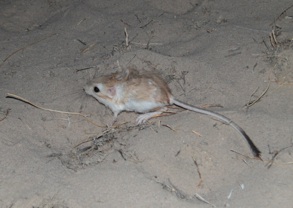BACKGROUND
Our project uses a number of approaches to examine the behavioral and physiological adaptations that prey (squirrels) and predators (rattlesnakes) evolve in response to each other. The process of adaptation and counter-adaptation that shapes squirrels and snakes, antagonistic coevolution, is the same evolutionary force that shapes hosts and parasites; plants and herbivores; pathogens and those afflicted by disease.
We are studying behavioral interactions between several different species of rattlesnakes (genus Crotalus) and some of the small mammals that they kill and eat. In particular, we are currently focusing on California ground squirrels (Otospermophilus beecheyi) and desert kangaroo rats (Dipodoyms deserti). These two small mammals have both evolved an elaborate series of signals and displays that they use to deter rattlesnakes. We are fundamentally interested in how, exactly, a small mammal can ward off a rattlesnake simply by displaying toward it.
Both of these systems are incredibly rich, behaviorally and physiologically, with many examples of adaptation and counter-adaptation in both parties. For example, rattlesnakes try to kill and eat squirrels using a series of specialized adaptations, including highly refined chemical senses, camouflage, the ability to see body heat, an extremely rapid strike, and very toxic venom. Squirrels have evolved counter measures to these attacks, including a suite of signals and displays that somehow deter snakes, extreme evasive dodge maneuvers to avoid strikes, and physiological resistance to snake venom.
These adaptations indicate that these species have sculpted each other in surprising ways over evolutionary time. For example, rattlesnakes have evolved the ability to use specialized thermal-imaging membranes in their facial pits to see body heat leaking from warm-blooded mammals. Squirrels that signal to rattlesnakes then evolved the ability to differentially heat their tail while displaying to pitvipers, which, for some reason (hopefully we’ll find out how), can alter the predatory behavior of the snake. Both systems contain numerous examples of this type of antagonistic coevolution, and our research is focused on teasing apart the behavioral complexities involved in the interaction between the two parties. By doing so, we hope to fundamentally transform our understanding of how predators and prey can evolve elaborate communication systems that honestly convey information to each other, even though their ultimate interests are opposed.
Please see our bibliography for a list of references that focus on predator-prey communication, coevolution, and small mammal/rattlesnake interactions.



